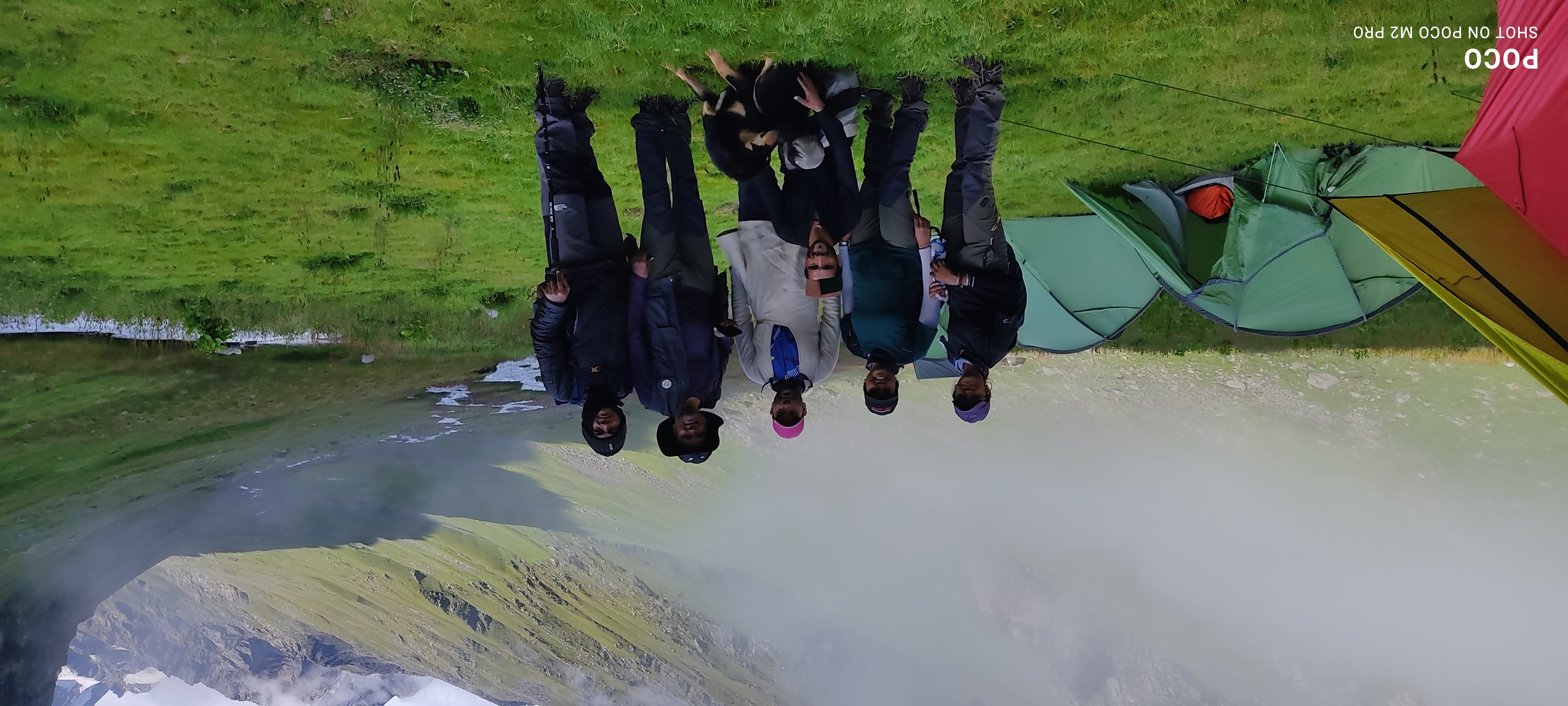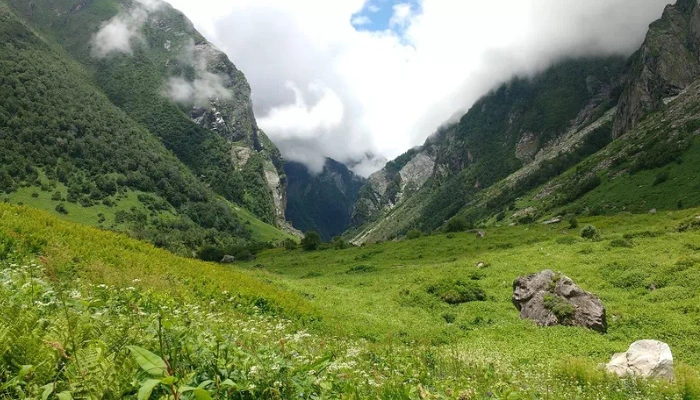
Kugti Pass Trek
TREK DIFFICULTY
Moderate
TREK DURATION
5 Days
HIGHEST ALTITUDE
16,600 feet
GROUP SIZE
12
TREK DISTANCE
32 km
BASECAMP
Himachal Pradesh
BEST TIME
June to Oct
PICKUP POINT
Himachal Pradesh
Kugti Pass Trek
Kugti Pass is a high-altitude pass situated in the Chamba district. This pass of Himachal Pradesh connects Chamba to Lahaul. It is a high-altitude pass with an elevation of 5,050 mts. Kugti Pass Trek is a Himalayan trail used by the Gaddi people for seasonal migration. This trek is not made only for tourism. Shepherds have been using this trail for centuries. It is a traditional route that covers large alpine meadows, thick forests, and glacial rivers.
The trek starts from Kugti village which is a very remote inhabited village of Barmour. It is rated as a moderate to difficult trek due to rough terrain and weather. You will pass glaciers and snowfields that can aid the difficulty level of the Kugti Pass trek. If you have experience in trekking or you are a beginner with great fitness then you can do this trek. This trek also holds cultural and spiritual value. Lots of trekkers and locals visit Karthik Swami Temple before ascending to Kugti Pass Trek. This temple is home to Lord Kartikeya and people often seek blessings before starting the trek. Locals and Gaddi people pray in this temple to complete the trek without any difficulties.
History of Kugti Pass Trek
Kugti Pass is a natural corridor between Bharmour and Lahaul. It is a very different kind of trek as you start with lush green forests and reach dry mountains. The elevation of Kugti Pass is 5,050 meters but you can still complete your trek without any special trekking gear or mountaineer experience. It is a common seasonal migration route for tribal people. These people take their flocks from lower altitude areas to the high pastures of Lahaul in the summer. During this time, the snow begins to melt, and the pastures turn green.
The Gaddi people are native to the Kugti. Most of them spend their whole life grazing cattle and fulfilling basic needs. You can witness the traditional practices of the Gaddi community. In the early 2000s, Kugti Pass gained the attention of trekkers who were in search of pure and untouched wilderness. Instead of a popular trekking destination, Kugti is more like a less-explored trek with rich traditional and spiritual significance. The Gaddi tribe and other natives still maintain the local traditions. Kugti Pass Trek is more like a trail to nature, mythology, and mountain lifestyle.
Highlights of Kugti Valley Trek
- Majestic Himalayan Views: Kugti Valley Trek offers you a beautiful view of the Pir Panjal and Dhauladhar ranges. You can also see Manimahesh Kailash on this trek. In clear skies, you can witness snow-covered peaks and big valleys. From the Kugti Pass, you can experience a 360-degree Himalayan view.
- Raw landscape: Himachal Pradesh is one of the most popular tourist states in our country. Still, Kugti Valley is raw. Most people don’t know about this valley and trek. It is a hidden gem of the state that offers stunning views and is rich in culture. You can see big coniferous forests, meadows, and even snow bridges.
- Explore Gaddi culture: Gaddis has been living in Kugti for centuries. They are native to this high-altitude village. It is a very remote area and people are still living there with minimal needs. Roam around the village and you can see traditional wool weaving. Shepherds still do seasonal migration and follow the ancient approaches.
- Spiritual Side of Kugti: Himalayas are the abode of God. Whether you visit Himachal or Uttarakhand, you will always sense the presence of God. In Kugti Pass Trek, you will see lots of big and small temples. Two major spots are Kartik Swami Temple and Mata Marali Temple. Locals believe that these deities protect the valley from any harm and calamities.
Difficulty Level Of Kugti Pass Trek
Kugti Pass Trek is often rated as a moderate to difficult trek by most trekkers. The difficulty level of this trek depends on the high altitude, weather, and terrain.
High-altitude
In most Himalayan treks, the difficulty level depends on the altitude. High altitude means more difficulty. The Kugti Pass Trek is 5,050 meters, which makes it difficult for some people. The rapid gain in some areas like Alyas and Dughi can cause AMS. After crossing 4,000 mts; oxygen level and temperature starts decreasing.
Weather conditions
Predicting weather conditions in high altitudes is very difficult. In early or late seasons, you might get sudden snowfall. The temperatures can drop to sub-zero degrees at night. Weather conditions can affect the trek, especially near the pass. If the trekker is not equipped with proper gear then he might get cold or even hypothermia.
Difficult Terrain
The trek passes through forests and meadows. In dry weather, the trail is easy in most of the parts. Trekking on snowfields and glacial crossings can be very difficult. The ice patches can be very dangerous and you require good balance and technique. The pathways are not properly constructed and can be very slippery during monsoon.
Very Remote Area
Kugti is a very remote village and after passing the village, you will see only a few trekkers and locals. Any kind of medical help is very difficult on the trek. The trekkers have to deal with all the injuries on their own. Trekkers should plan the trip with a good trekking company. Only your trekking team can help you on the trek.
Best Time To Visit Kugti Pass Trek
You can plan your Kugti Pass Trek from Spring to Autumn. The snow starts melting and the pass becomes accessible to the trekkers. However, the terrain and the views are different in every season.
- Kugti Pass Trek from May to June
This is an early season for Kugti Pass Trek. If you are a snow lover then you can plan this trek in June. Lower altitude meadows become green and the Himalayan view will be clear. The weather will be cool in the daytime but the night can be very cold. You will find fewer trekkers and you might see Rhododendron bloom.
- Kugti Pass Trek in July to Mid-August
It is monsoon weather and you can see frequent rain in Kugti and Bharmour. The trails will be very slippery but you see lush green forests and beautiful waterfalls. Meanwhile, you may face landslides in some areas. Leeches and insects are very common in lower areas. Trek can be difficult in monsoon.
- Kugti Pass Trek in Late August to September
After the monsoon, you can see clear skies. You won’t see snow or heavy rain on the trek. Some seasonal rivers will be flowing. The temperature will start dropping and you can witness the green meadows turning to golden.
- Kugti Pass Trek in October
The early winter season is only for experienced trekkers. Snowfall can make the trek very difficult. The campsites can be very cold at night. Everything will start turning brown and cold winds start blowing at high altitudes. You can witness dramatic landscapes in this season.
How To Reach Kugti Pass Trek?
To start your Kugti Pass Trek, you have to reach Bharmour. You can reach Bharmour via road or you can travel to Pathankot via train and then book a cab to Bharmour.
- Kugti Valley via Train: You won’t get a direct train to Bharmour. The nearest railway station to Kugti Pass is Pathankot. You can find trains to Pathankot from all major cities like Delhi, Mumbai, Chandigarh, etc. After reaching Pathankot, look for HRTC buses or private taxis to Chamba. The distance is about 180 km. From Chamba, you can take a taxi or bus to Bharmour.
- Kugti Valley via Bus: You can book an overnight bus from Delhi to Pathankot. Bus services are also available from Amritsar and Chandigarh. You can find HRTC and Volvo buses to Pathankot. Now you can take a bus to Chamba and then take a shared taxi to Bharmour. You can stay overnight at Bharmous and start your trek early the next day.
- Kugti Valley via Air: Pathankot also has an airport. But the flights to this airport are very limited. You can also book a flight to Gaggal Airport in Dharamshala. Buses are available from Dharamshala to Pathankot. Now take a bus to Chamba and then take a taxi to Bharmour. The next day, hire a local taxi from Bharmour to Kugti.
Day 1: Reach Bharmour in the morning and start your trek to Kugti village. Drive from Bharmour to Dharol and then trek to Kugti village. The trek is approx 5 km and will take 2-3 hours to complete.
Day 2: Start your trek from Kugti to Guggi. The trek is about 7 km and you can also visit Klang Temple.
Day 3: Today you have to trek from Duggi to Alyas. The trek is 8 km long and you will gain a lot of altitude.
Day 4: Start the trek to Kugti Pass and reach Kodlu Alyas. The terrain is very challenging and you have to trek for about 10 hours.
Day 5: Start the trek from Alyas to Rappe via beautiful meadows.
Himalaya Shelter offers the best trekking services for Kugti Pass Trek. Our team is highly skilled in all high-altitude treks. You can contact our team and customize your trek. Our trek leaders and other staff will take care of everything. You can book the trek solo or in a group. We also provide customization on meals and other services. Plan your trek with the Himalayan Shelter and complete your trek without any worry.
Our team is focused on eco-conscious travel and local hospitality. Our goal is to provide the best trekking experience. Your trekking journey will be safe and smooth with us. Let our team take you on the healing journey in the mountains.
Day 1: Bharmour to Kugti village (8,500 ft) | Trek: 5 km in 2 - 3 hrs
Bharmour to Dharol in vehicles,Then trek from Dharol to Kugti Village is approximately 5 kilometers.
Kugti Village is situated at an altitude of approximately 8,500 feet (2,590 meters) above sea level.
Day 2: Kugti to Duggi (10,500 feet) via Kelang temple | Trek: 7 km in 4 - 5 hrs
Start the trek from Kugti to Duggi via Kelang Temple is approximately 7 kilometers.
Arrival at Duggi and stay overnight there
Day 3: Duggi to Alyas (13,900 feet) | Trek: 8 km in 5 - 6 hrs
Start the trek from Duggi to Alyas The trail will lead you through diverse landscapes, including meadows
Arrive in Alyas and take some time to rest and acclimatize to the higher altitude.
Day 4: Alyas to Kodlu Alyas (12,500 ft) Via Kugti Pass (16,600 ft) | Trek: 8 km in 10 - 11 hrs
Start the trek from Alyas to Kodlu Alyas via Kugti Pass This trek is extremely challenging and can take about 10 to 11 hours,
Ascent to Kugti Pass at an altitude of approximately 16,600 feet (5,059 meters)
Descent to Kodlu Alyas Take some time to rest, rehydrate, and allow your body to recover from the strenuous journey.
Day 5: Alyas to Rappe (9,500 feet) | Trek: 4 km in 3 - 4 hrs
Start the trek The trek from Alyas to Rappe is approximately 4 kilometers.
The trail will lead you through diverse landscapes, including meadows, forested areas
Rappe is situated at an altitude of approximately 9,500 feet (2,896 meters) above sea level.
Kugti Pass Inclusions
- Accommodation for a total 4 Nights
- Meals from Day 1 Dinner to Day 5 Breakfast will be served. Veg Meals with Egg options can be served. Jain meals can be arranged on request.
- Certified Trek Leader, Cook and Support Staff
- Camping Equipment including tents, kitchen & dining tents, toilet tents etc Gaiters, Microspikes
- Forest Permits
Kugti Pass Exclusions
- Any Add Ons apart from the inclusions above
Read More on Kugti Pass Trek
Treks by Categories
Treks By Month

Treks By Experience


















